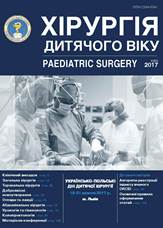Substantiation of treatment tactics in young children with congenital malformations associated with undifferentiated connective tissue dysplasia
DOI:
https://doi.org/10.15574/PS.2017.57.80Keywords:
young children, undifferentiated connective tissue dysplasia, congenital malformations of the urinary system, optimization of treatmentAbstract
Objective. To substantiate the treatment tactics in young children with congenital malformations of the urinary system (CMUS) associated with undifferentiated connective tissue dysplasia (UCTD).Material and methods. 210 children of early age with pyelonephritis were examined on the background of CMUS, who were divided into 4 research groups: I ‑ with quantitative and positional abnormalities of kidney development (76 children), II ‑ with vesicoureteral reflux of various degrees (67), III ‑ with congenital hydronephrosis (53), IV ‑ with abnormalities of formation and differentiation of renal tissue – normonephronic hypoplasia and multicystic kidney dysplasia (14). The control group included 65 children with pyelonephritis without CMUS. In the urine of these children, the content of hydrooxyproline (HOP) was determined for the diagnosis of the presence or absence of UCTD and the markers of the morphofunctional status of the renal parenchyma.
Results and discussion. In children with CMUS of all groups compared with the control one, the phenotypic, clinical and biochemical signs of UCTD were more reliably recorded. HOP was most often detected in the urine of children with congenital hydronephrosis and the formation and differentiation of renal tissue anomalies. Excretion of polar lipids with daily urine was significantly higher in children with CMUS and UCTD association and it was the, most pronounced in patients with vesicoureteral reflux and congenital hydronephrosis. A significant decrease of creatinine excretion and an increase of glycosaminoglycan excretion with urine, markers of the renal parenchyma sclerotherapy was observed in 85% of children with CMUS, which was more pronounced in patients with UCDT.
Conclusions. The results of biochemical examinations make it necessary to supplement the complex of conservative therapy of children with CMUS and the phenotypic and biochemical features of UCDT with preparations stimulating collagen formation and have a bioenergetics effect by L-carnitine and vitamins B6 and E.
Downloads
Issue
Section
License
The policy of the Journal “PAEDIATRIC SURGERY. UKRAINE” is compatible with the vast majority of funders' of open access and self-archiving policies. The journal provides immediate open access route being convinced that everyone – not only scientists - can benefit from research results, and publishes articles exclusively under open access distribution, with a Creative Commons Attribution-Noncommercial 4.0 international license(СС BY-NC).
Authors transfer the copyright to the Journal “PAEDIATRIC SURGERY.UKRAINE” when the manuscript is accepted for publication. Authors declare that this manuscript has not been published nor is under simultaneous consideration for publication elsewhere. After publication, the articles become freely available on-line to the public.
Readers have the right to use, distribute, and reproduce articles in any medium, provided the articles and the journal are properly cited.
The use of published materials for commercial purposes is strongly prohibited.

